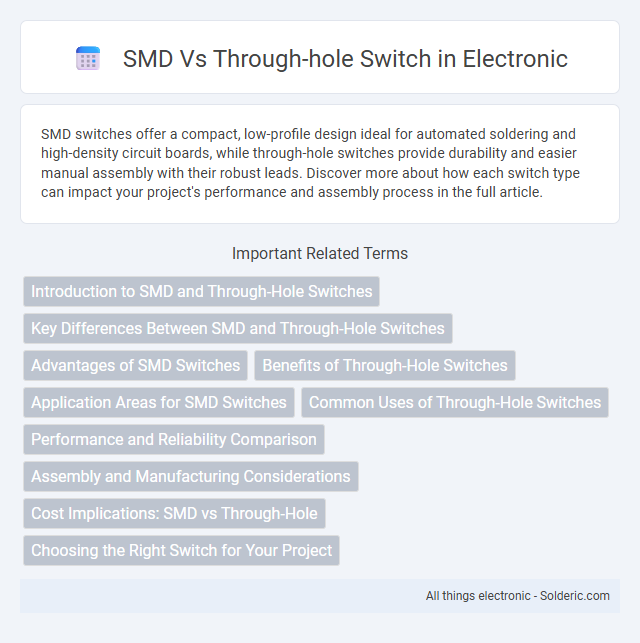SMD switches offer a compact, low-profile design ideal for automated soldering and high-density circuit boards, while through-hole switches provide durability and easier manual assembly with their robust leads. Discover more about how each switch type can impact your project's performance and assembly process in the full article.
Comparison Table
| Feature | SMD Switch | Through-Hole Switch |
|---|---|---|
| Mounting Type | Surface Mount Device (SMD) | Leads inserted through PCB holes |
| Size | Compact, low-profile | Larger, bulkier |
| Assembly Method | Automated pick-and-place machines | Manual or wave soldering |
| Mechanical Strength | Less durable under stress | Highly durable and robust |
| Repair and Replacement | Challenging, requires specialized tools | Easy to replace and solder |
| Electrical Performance | Suitable for high-frequency applications | Better for high-current situations |
| Cost | Generally lower in mass production | Higher for manual assembly |
| Typical Applications | Compact electronics, smartphones, wearables | Industrial equipment, rugged or high-power devices |
Introduction to SMD and Through-Hole Switches
SMD (Surface-Mount Device) switches are designed for compact, automated PCB assembly, offering advantages in space-saving and high-frequency applications. Through-hole switches feature long leads inserted into drilled holes on the PCB, providing robust mechanical strength for applications requiring durability and repeated cycling. Understanding the distinction between SMD and through-hole switches helps optimize your electronic design for performance, size, and assembly method.
Key Differences Between SMD and Through-Hole Switches
SMD switches are surface-mounted components designed for automated assembly, offering compact size and higher density on PCBs, while through-hole switches feature leads that pass through the board for stronger mechanical bonds and easier manual soldering. SMD switches are ideal for modern, high-frequency circuits due to reduced parasitics, whereas through-hole switches provide greater durability and reliability in mechanically stressed environments. Your choice between these switch types depends on the application's space constraints, assembly method, and mechanical requirements.
Advantages of SMD Switches
Surface-mount device (SMD) switches offer significant advantages over through-hole switches, including a smaller footprint that enables higher component density on printed circuit boards (PCBs). Their low profile enhances reliability by reducing mechanical stress and improving performance in compact electronic devices. Choosing SMD switches can optimize your product's manufacturing efficiency and support automated assembly processes, reducing production costs.
Benefits of Through-Hole Switches
Through-hole switches provide superior mechanical strength and durability, making them ideal for applications requiring reliable long-term performance under stress or vibration. Their larger size and leads allow for easier manual soldering and repair, offering convenience during prototyping or low-volume production. You benefit from enhanced electrical connection integrity, especially in high-current or high-voltage circuits, reducing the risk of failure.
Application Areas for SMD Switches
SMD switches are widely used in compact electronic devices such as smartphones, laptops, and wearable technology due to their small size and ease of automated assembly. Their surface-mount design enables high-density circuit board configurations, making them ideal for applications where space and weight are critical factors. Industries like consumer electronics, medical devices, and automotive electronics frequently employ SMD switches for reliable and efficient switching functions.
Common Uses of Through-Hole Switches
Through-hole switches are predominantly used in applications requiring high mechanical strength and durability, such as industrial equipment, automotive controls, and audio devices. Their larger size allows for easier manual operation and reliable soldering on printed circuit boards (PCBs) subject to mechanical stress or frequent use. These switches excel in prototyping and repair scenarios due to straightforward installation and robust connections.
Performance and Reliability Comparison
SMD switches offer superior performance in high-frequency applications due to their lower parasitic inductance and capacitance compared to through-hole switches. Through-hole switches typically provide higher mechanical robustness and enhanced reliability in harsh environments because of their stronger solder joint connections. SMD switches excel in compact, automated assembly environments, while through-hole switches remain preferred for applications requiring greater mechanical durability and ease of manual repair.
Assembly and Manufacturing Considerations
SMD switches enable automated pick-and-place assembly, reducing labor costs and increasing production speed compared to through-hole switches, which require manual insertion or wave soldering. SMD components support higher component density on PCBs, improving design efficiency and reliability in mass manufacturing. Your choice impacts assembly complexity, with through-hole preferred for mechanical strength and prototyping, while SMD suits high-volume automated production lines.
Cost Implications: SMD vs Through-Hole
Surface-mount device (SMD) switches typically offer lower manufacturing costs due to automated assembly processes that reduce labor and increase production speed compared to through-hole switches, which require manual insertion and soldering. SMD switches also save space on printed circuit boards (PCBs), enabling more compact designs and potentially reducing overall material expenses. However, through-hole switches may incur higher costs because of their robust mechanical strength and ease of prototyping, often preferred in applications demanding durability or frequent testing.
Choosing the Right Switch for Your Project
Choosing the right switch involves evaluating factors such as space constraints, durability, and assembly method. Surface Mount Device (SMD) switches offer compact size and suitability for automated manufacturing, making them ideal for high-density circuit boards and mass-produced electronics. Through-hole switches provide greater mechanical strength and are easier to replace, which is beneficial for prototyping or projects requiring robust, manually assembled components.
SMD vs through-hole switch Infographic

 solderic.com
solderic.com